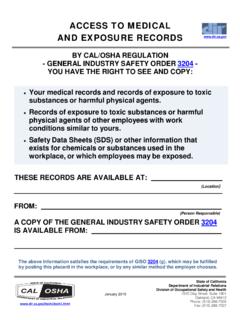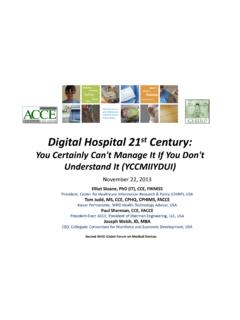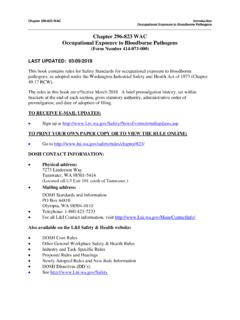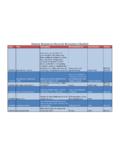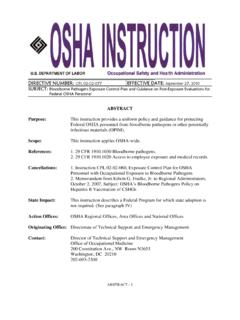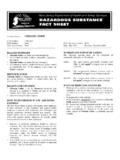Transcription of Summary of OSHA’s Hexavalent Chromium Standard 1910
1 Summary of OSHA s Hexavalent Chromium Standard This is Summary of the highlights of this new Standard . Reference should be made to the Standard for more details. I. Scope The Standard applies to all occupational exposures to Chromium except those due from portland cement and pesticides. II. Permissible Exposure Limit (PEL) The PEL is micrograms as an 8-hour time-weighted average. The Action Level (AL) is half of this. III. Exposure Determination A. Initial exposure monitoring is required to measure an 8-hour time-weighted average. B. Sampling is also required whenever there is a change that could result in an exposure at or above the Action Level. C. Sampling frequency is dependent upon results.
2 (See Section IV below.) D. A sampling strategy should include breathing zone air samples to accurately characterize exposure on each shift, each job classification and each work area. E. When representative sampling is performed on selected employees rather than all employees, the employees with the highest expected exposure must be selected for exposure monitoring. F. Sampling and analytical methods must meet minimum accuracy requirements. G. Affected employees or their representatives must be given the opportunity to observe the monitoring procedure. H. If personal protective equipment (PPE) is required in the area being monitored, PPE must be provided to the observers and they must be trained in proper use of the equipment.
3 IV. Actions Following Sampling Results Sample Result Resample Requirements Other Requirements Less than AL No* No Equal to or Greater than AL Less than PEL At least every 6 months medical Surveillance Greater than PEL At least every 3 months medical Surveillance Employee Notification Regulated Area Protective Equipment *If initial monitoring results are at or above the AL and methods to reduce exposure result in concentrations below the AL, a second set of samples must be taken at least 7 days later to verify this reduction. If results remain below the AL, additional sampling is not required. Hexavalent Chromium Standard Bessa & Associates, Inc. Page 2 V. Employee Notification if over PEL Employees must be notified via posting or individually in writing within 15 or less days following receipt of sample results.
4 The notification must include the corrective action being taken to reduce exposure. VI. Methods of Compliance How to Reduce Exposure A. Engineering controls and work practices must be used to reduce exposure to or below the PEL unless it can be demonstrated that such controls are not feasible. B. Employee rotation to lower exposure is prohibited. C. If exposure occurs less than 30 days per year (12 consecutive months), respiratory protection may be used in lieu of engineering controls or work practices to reduce exposure. D. Respiratory protection may also be needed during: 1. periods necessary to install controls or alter work practices 2. if engineering controls and work practices have not adequately reduced exposure 3.
5 Emergencies E. A Respiratory Protection program that meets the requirements of is required if respirators are used. F. Use of compressed air to clean is prohibited unless dust collection is provided or if there is no feasible alternative. G. Dry shoveling, brushing, sweeping is prohibited. VII. Protective Work Clothing and Equipment A. PPE must be provided when there exists an eye or skin contact with Cr VI. B. All contaminated PPE and equipment must be removed at the end of the shift or the end of the procedure where exposure to Chromium VI occurs. C. Contaminated PPE or equipment must not be taken home. D. Bags or containers with contaminated items must be labeled according to the OSHA Hazard communication Standard ( ) E.
6 The employer must launder, clean, maintain and dispose of all contaminated equipment. Anyone who launders clothing or cleans PPE must be informed of the potential harmful effects of Hexavalent Chromium and must clean and launder in a manner that minimizes eye and skin contact. F. Change rooms and washing facilities must be readily accessible for all employees with Hexavalent Chromium exposure if over the PEL. G. Eating and dining areas must be kept as free as possible from contamination with Hexavalent Chromium . H. Eating, drinking, applying cosmetics, smoking, chewing tobacco or gum are prohibited in areas where eye or skin contact with Hexavalent Chromium may occur. Hexavalent Chromium Standard Bessa & Associates, Inc.
7 Page 3 VIII. medical Surveillance A. medical surveillance is required for those who are: 1. At or above the Action Level for 30 or more days in 12 months 2. Experiencing signs or symptoms of adverse health effects associated with Chromium VI exposure. 3. Exposed in an emergency B. Surveillance must be completed: 1. Within 30 days of initial assignment or an emergency exposure. 2. Annually if exposure is 30 days or more in 12 months 3. Whenever signs or symptoms of adverse health effects appear 4. At termination of employment C. Surveillance must be performed by a Physician or other Licensed Healthcare Professional (PLHCP) and includes: 1.
8 medical and work history and examination with emphasis on the skin and respiratory tract. 2. Any additional tests deemed appropriate by the PLHCP. D. Information on exposure, job tasks and PPE must be shared with the PLHCP. E. PLHCP shall provide a written opinion containing: 1. Whether employee has any detected medical conditions that would cause an increased risk from continued exposure to Hexavalent Chromium . 2. Any recommended limitations. F. PLHCP must provide a statement that they reviewed results with the employee. Personal medical information must be kept confidential. IX. Hazard Communication Employee information and training must include: A.
9 Information on this Standard . B. Purpose and description of medical surveillance program. C. Health effects and proper use information as required by the Hazard Communication Standard . X. Recordkeeping Detailed records must be kept on A. Air Monitoring B. medical Surveillance XI. Effective Dates: A. Employers with 20 or more employees: all requirements except engineering controls by November 27, 2006. B. Employers with 19 or fewer employees: all requirements except engineering controls by May 30, 2007. C. For all employers, all engineering controls by May 31, 2010. Sharon Bessa Morey, CIH, COHN
